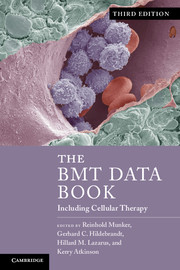75 results
Section 5 - Cellular therapy
-
- Book:
- The BMT Data Book
- Published online:
- 05 August 2013
- Print publication:
- 21 February 2013, pp -
-
- Chapter
- Export citation
11 - Therapeutic decision making in SCT for amyloidosis
-
-
- Book:
- The BMT Data Book
- Published online:
- 05 August 2013
- Print publication:
- 21 February 2013, pp 133-138
-
- Chapter
- Export citation
Preface
-
-
- Book:
- The BMT Data Book
- Published online:
- 05 August 2013
- Print publication:
- 21 February 2013, pp xi-xii
-
- Chapter
- Export citation
26 - Organ-related and miscellaneous complications
-
-
- Book:
- The BMT Data Book
- Published online:
- 05 August 2013
- Print publication:
- 21 February 2013, pp 348-410
-
- Chapter
- Export citation
10 - Therapeutic decision making in hematopoietic SCT for multiple myeloma
-
-
- Book:
- The BMT Data Book
- Published online:
- 05 August 2013
- Print publication:
- 21 February 2013, pp 122-132
-
- Chapter
- Export citation
Section 4 - Nonmalignant disorders
-
- Book:
- The BMT Data Book
- Published online:
- 05 August 2013
- Print publication:
- 21 February 2013, pp -
-
- Chapter
- Export citation
Section 2 - Hematologic malignancies
-
- Book:
- The BMT Data Book
- Published online:
- 05 August 2013
- Print publication:
- 21 February 2013, pp -
-
- Chapter
- Export citation
Section 7 - Complications
-
- Book:
- The BMT Data Book
- Published online:
- 05 August 2013
- Print publication:
- 21 February 2013, pp -
-
- Chapter
- Export citation
Index
-
- Book:
- The BMT Data Book
- Published online:
- 05 August 2013
- Print publication:
- 21 February 2013, pp 529-543
-
- Chapter
- Export citation
Section 8 - The BMT/SCT pharmacopoeia
-
- Book:
- The BMT Data Book
- Published online:
- 05 August 2013
- Print publication:
- 21 February 2013, pp -
-
- Chapter
- Export citation
21 - Practical aspects and procedures, including conditioning protocols and haploidentical transplantation
-
-
- Book:
- The BMT Data Book
- Published online:
- 05 August 2013
- Print publication:
- 21 February 2013, pp 235-287
-
- Chapter
- Export citation
Section 9 - HLA-testing and laboratory medicine
-
- Book:
- The BMT Data Book
- Published online:
- 05 August 2013
- Print publication:
- 21 February 2013, pp -
-
- Chapter
- Export citation
4 - Therapeutic decision making in BMT/SCT for acute lymphoblastic leukemia
-
-
- Book:
- The BMT Data Book
- Published online:
- 05 August 2013
- Print publication:
- 21 February 2013, pp 41-55
-
- Chapter
- Export citation
Section 1 - Basic science
-
- Book:
- The BMT Data Book
- Published online:
- 05 August 2013
- Print publication:
- 21 February 2013, pp -
-
- Chapter
- Export citation
12 - Therapeutic decision making in BMT/SCT for nonseminomatous germ cell tumor of testis
-
-
- Book:
- The BMT Data Book
- Published online:
- 05 August 2013
- Print publication:
- 21 February 2013, pp 139-145
-
- Chapter
- Export citation
14 - Therapeutic decision making in BMT/SCT for soft tissue sarcomas
-
-
- Book:
- The BMT Data Book
- Published online:
- 05 August 2013
- Print publication:
- 21 February 2013, pp 159-164
-
- Chapter
- Export citation

The BMT Data Book
- Including Cellular Therapy
-
- Published online:
- 05 August 2013
- Print publication:
- 21 February 2013
Section 3 - Solid tumors
-
- Book:
- The BMT Data Book
- Published online:
- 05 August 2013
- Print publication:
- 21 February 2013, pp -
-
- Chapter
- Export citation
Section 6 - Practical aspects and procedures
-
- Book:
- The BMT Data Book
- Published online:
- 05 August 2013
- Print publication:
- 21 February 2013, pp -
-
- Chapter
- Export citation
Acknowledgments
-
- Book:
- The BMT Data Book
- Published online:
- 05 August 2013
- Print publication:
- 21 February 2013, pp xiii-xiv
-
- Chapter
- Export citation



